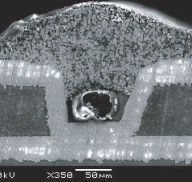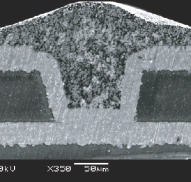There are prints where air bubbles are absolutely unacceptable.
For example, sticker printing for organic EL displays. Then there is also hole-filling printing with conductive paste (silver, copper, etc.).
For such printing, it used to be necessary to use a defoaming device to remove air bubbles by creating a vacuum around the workpiece after printing.
For example, sticker printing for organic EL displays. Then there is also hole-filling printing with conductive paste (silver, copper, etc.).
For such printing, it used to be necessary to use a defoaming device to remove air bubbles by creating a vacuum around the workpiece after printing.
However, since the formation of air bubbles is not constant, the amount of paste after defoaming becomes unstable with the defoaming equipment. In other words, removing air bubbles after printing is too late.
Our Vacuum Screen Printer encloses the entire printing part in a chamber, and by printing in a vacuum state inside it, it is possible to print with a stable amount of ink without air bubbles.
Now let's compare vacuum printing with regular printing. The first sheet is printed under atmospheric pressure, and the second sheet is vacuum printed.
You can see that air bubbles are included in the atmospheric pressure printing, but the paste is properly filled to the corners*1 without any gaps in the vacuum printing.
*1 The action of differential pressure filling is also used.

[Filling holes with conventional printing]
(bubbles will enter)
(bubbles will enter)

[Filling holes with vacuum printing]
(no air bubbles)
(no air bubbles)
If you are having trouble with poor product yield due to air bubbles in the current method, why not try to replace it with vacuum printing, which does not require a defoaming device and has a stable ink filling volume?
We look forward to hearing from you.
